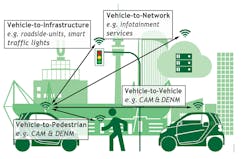What you’ll learn:
- The major advantages that 5G is expected to bring to V2X applications.
- Are there privacy issues surrounding V2X technology?
- Results from 5GAA V2X testing.
Vehicle-to-everything (V2X) technology is the future of vehicular transportation. Communications between vehicles on the road (V2V) and between vehicles and traffic infrastructure (V2I), such as streetlights and pedestrian crossings, will greatly enhance automotive safety features and ease traffic congestion. V2X uses 5G to transmit signals to and from automobiles, pedestrians, and traffic cameras/sensors to make driving safer and more convenient.
Let’s explore five ways that 5G in V2X applications will deliver new capabilities using better connectivity and lower latency than current vehicular dedicated short-range communications (DSRC) systems.
A Technological Evolution is Coming
V2X and 5G will enhance road safety with notifications about approaching emergency vehicles—including distance and directional information—and school/pedestrian crossings. School buses will be able to notify nearby vehicles when children are about to cross the road, and delivery trucks can let the surrounding area know when they’re blocking off a lane of traffic on a busy street. Information on traffic congestion would be relayed in real-time, warnings about road accidents or traffic jams would be transmitted seconds after they occur.
Pedestrians could even get warnings from their cellphones about vehicles driving erratically or at unsafe speeds in their immediate vicinity. They would hear a loud alarm just before stepping out into the road as a speeding vehicle careens through the intersection after running a red light.
Cellular vehicle-to-everything (C-V2X) is a subset of V2X and will be able to supplement line-of-sight (LOS) sensors such as cameras, radar, and LiDAR with non-LOS awareness, a critical factor in safe autonomous driving. C-V2X also will provide a wider range of coverage than LOS sensors and is the foundation for vehicles to communicate with other connected devices.
In addition to V2X, 5G will enable V2V, V2I, vehicle-to-network (V2N), vehicle-to-pedestrian (V2P) and vulnerable road users such as cyclists, vehicle-to-device (V2D), and vehicle-to-grid (V2G) communications for electric-vehicle power transfers.
Improved Safety Via DSRC and C-V2X
Autonomous vehicles employ high-speed communication protocols for vehicle safety: DSRC and C-V2X. These two protocols operate at an extremely high speed with a high-frequency data exchange at low latency.
DSRC maintains a data rate of 6 to 26 Mb/s in the 5850- to 5925-MHz band; C-V2x has 26 Mb/s (RX), max 26 Mb/s (TX). DSRC and C-V2X radios have no connections, but they broadcast vehicle location, speed, and acceleration while listening to other signals.
Safe and Reliable Communications at All Ranges
5G brought sidelinking to industry C-V2X by advancing C-V2X applications such as platooning, advanced driving, extended sensors, and remote driving. Strict latency and high reliability are required because of emergency braking and collision avoidance in critical driving situations. C-V2X’s shortest transmission latency is no more than 4 ms—it can be faster depending on the implementation.
The bulk of the traffic carried out by short-range communications—especially in the first phase of V2X deployment—will be periodic broadcasting of messages by each vehicle communicating its status and movements.
In dense traffic areas, available channel resources will saturate the area and increase packet losses, potentially endangering drivers. Congestion control algorithms were examined and defined to modify certain parameters before these conditions reached critical levels. C-V2X sidelink is the first wireless system to introduce distance as a dimension at the physical layer, enabling a uniform communication range for both LOS and non-LOS implementations.
Security/Privacy in V2X Communication
LTE-based V2X communication uses high-capacity, large-cell coverage range, as well as widely deployed infrastructure to support various types of vehicular communication services for safety and non-safety applications. Organizations such as 3GPP and Qualcomm have already prepared the roadmap for 5G-based V2X services.
Security defined in 3GPP mainly includes confidentiality, integrity, authenticity, and resistance to replay attacks. New privacy and security challenges like secure mobility management for group-oriented autonomous platoons, reliable cooperative driving, efficient and privacy-preserving vehicular big data sharing and processing, etc., will require further investigation.
V2X applications depend on continuous, detailed location information, which can lead to privacy concerns. In a privately owned vehicle, location traces will reveal the movements and activities of the driver (who may or may not be the owner of the vehicle). Sending and disseminating V2X user location information can create possible privacy concerns for both car owners and renters/borrowers.
Other V2X applications include communication between vehicles, augmenting existing methods to help with left- or right-turn assistance, emergency braking warnings, and improved situational awareness at intersections. Extending Waze concepts, it can control or suggest speed adjustments to account for traffic congestion and update a GPS map with real-time updates on lane closure and highway construction activity.
V2X is essential to support over-the-air (OTA) software updates for the now-extensive range of software-driven systems in your car, from map updates to bug fixes to security updates, etc.
V2X Message Protection/Security
V2X communications require strong security to protect messages against fraudulent or misleading use, leading to safety and privacy issues. Another security method is signed messages using Public Key Certificates to prevent unauthorized parties from interfering with the exchange of data and pseudonymize the communication securely.
Public key infrastructure (PKI) consists of policies and procedures used to create, manage, use, save, and revoke digital security certificates. PKI allows for electronic information transfer securely and goes beyond just passwords as authentication with a requirement of more rigorous identity confirmation.
Testing for Robust V2X Performance
The importance of predicting the performance of V2X communications in various real-world scenarios can’t be overstated. With driver, passenger, and pedestrian safety of critical importance, testing before deployment is required. Laboratory testing is a critical first phase in proving out important assumptions and testing for unexpected circumstances.
In one such test, the 5G Automotive Association (5GAA) ran V2X performance and functional tests in the V2X Functional and Performance Test Report. C-V2X technology alone was tested for a highly congested scenario in a laboratory setting. Even in this congested scenario, C-V2X latency remained bounded by the 100-ms latency budget configured for that scenario. Some of the key observations of these tests included:
- C-V2X communication in 20-MHz CH183 has the same reliability performance (Packet Reception Ratio vs. distance) as the identical BSM-like message transmission in 10-MHz CH184.
- Impact of C-V2X high load transmissions in CH183 on DSRC basic safety transmissions in CH172 is negligible up to a 1.4-km range in LOS conditions.
- Impact of C-V2X high load transmissions in CH183 on V2I and I2V transmissions in CH178 is negligible up to a 1.4-km range in LOS conditions.
- Impact of C-V2X high load transmissions in CH183 on V2I and I2V transmissions in CH180 is negligible up to 1 km in LOS conditions.
Ford and Qualcomm performed additional field tests supporting the latest 5GAA petition for waiver with the Federal Communications Commission for C-V2X deployment. C-V2X performed well, especially LOS conditions.
According to the 5GAA, C-V2X was deemed ready for deployment with commercial chipsets and was seen as ready to start in-vehicle global deployment. The 5GAA will partner with the relevant standards developing organizations (SDOs) to drive the requirements of 5G V2X to create a successful V2X ecosystem.
Conclusion
We can see the possibilities, but V2X is in its infancy, and we might not be able to fully enjoy many of the technology’s benefits until it matures. Most traffic systems are not V2X-compatible yet. However, as the systems become more common, traffic systems will be able to adjust the timing of traffic lights on an as-needed basis to alleviate traffic congestion, such as how freeways use metering lights (usually on timers) to avoid gridlock.
Vehicle-to-everything technology could make great strides in the next 20 or so years. Many new car models use some form of V2X technology, particularly luxury brands. Most luxury automobile amenities (leather seats, sunroofs, cruise control) eventually become common in cars at all price ranges.
It's anticipated that V2X connectivity will be a crucial capability in vehicles with autonomous-driving systems (ADS), which assess their environments for potential dangers and then react accordingly. The more information about the surrounding environment an ADS has at its disposal, the better decisions it will make. 5G will make connectivity—from cellphones to traffic lights to onboard navigation systems—the future of transportation.
About the Author

Steve Taranovich
Freelance Technical Writer, Phoenix Information Communication LLC
Steve is a contributing editor to Electronic Design.
Author of the non-fiction “Guardians of the Right Stuff,” a true story of the Apollo program as told by NASA and Grumman Corp. engineers, an astronaut, and technicians.
Experienced Editor-In-Chief of EETimes/Planet Analog and Senior Technical Editor at EDN running the Analog and Power Management Design Centers from 2012 to 2019.
A demonstrated history in electronic circuit design and applications for 40 years, and nine years of technical writing and editing in industry. Skilled in Analog Electronics, Space-related Electronics, Audio, RF & Communications, Power Management, Electrical Engineering, and Integrated Circuits (IC).
1972 to 1988 worked as a circuit design engineer in audio (8 years) and microwave (8 years). Then was Corporate Account Manager/applications engineer for Burr-Brown from 1988 to 2000 when TI purchased Burr-Brown. Worked for TI from 2000 to 2011.
Strong media and communication professional with a BEEE from NYU Engineering in 1972 and an MSEE from Polytechnic University in 1989. Senior Lifetime member of IEEE. Former IEEE Long Island, NY Director of Educational Activities. Eta Kappa Nu EE honor society member since 1970.

